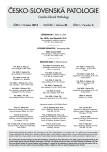Xylene; a useful marker for agricultural products ingestion
Xylen – užitečný marker požití toxických látek užívaných v zemědělství
Informujeme o případu požití malathionu (organofosfátový insekticid). Během pitvy bylo provedeno GC/MS vyšetření žaludečního obsahu metodou headspace. Byly identifikovány izomery xylenu. Následným vyšetřením byl v žaludečním obsahu prokázán malathion. Vyšetření žaludečního obsahu metodou headspace může poskytnout při záchytu toxických látek užitečné informace. Xylén i jiné těkavé látky jsou často užívány jako rozpouštědla v komerčních průmyslových výrobcích a měla by jim být věnována náležitá pozornost.
Klíčová slova:
malathion – organofosfáty – insekticidy
Authors:
Hiroshi Kinoshita 1; Naoko Tanaka 1; Mostofa Jamal 1; Mitsuru Kumihashi 1; Kunihiko Tsutsui 2; Kiyoshi Ameno 1
Authors place of work:
Department of Forensic Medicine, School of Nursing, Faculty of Medicine, Kagawa University, Kagawa, Japan
1; Department of Health Sciences, School of Nursing, Faculty of Medicine, Kagawa University, Kagawa, Japan
2
Published in the journal:
Soud Lék., 58, 2013, No. 4, p. 59-60
Category:
Původní práce
Summary
Here we report about a case of malathion (an organophosphate insecticide) ingestion. Headspace analysis of stomach content provided useful information for screening of toxic chemicals. We should pay attention to solvents used in commercial industrial products.
Keywords:
malathion – organophosphates – insecticides
REPORT OF A CASE
A male in his sixties was found dead, lying on his back on the seashore. Moderately early changes of decomposition were observed, and the postmortem interval was estimated at approximately 5-7 days. The medico-legal autopsy revealed no evidence of external injury. There was no finding of disease. The heart weighed 224 g, without containing blood in the ventricles, and the brain weighed 1200 g. Left and right lungs weighted 223 g and 250 g, respectively, and all organs showed moderate decomposition. The stomach contained a brown oily liquid, which emitted a strange odor like a solvent. As blood samples could not collected due to the postmortem changes, the stomach content was collected for toxicological examination.
During autopsy, the headspace gas chromatography mass spectrometry (GC/MS) analysis of the stomach content identified the presence of isomers of xylene. It was carried out according to previous reports with slight modification (1). GC/MS analysis was performed on a QP-2010 (Shimadzu, Kyoto, Japan) and the MS system was operated in the electron-impact mode. The identification of the each of the compounds were achieved from retention time and mass spectra. Principle mass ions were detected at m/z 91, 106, 77 and 51, as same in the authentic solution of xylene.
Subsequent toxicological analysis also revealed the presence of malathion (S-1,2 bis (ethoxycarbonyl) ethyl o, o-dimethyl phosphorodithioate) in the stomach content, according to the method of the previous report by GC/MS (2), and its identification was achieved from retention time and mass spectra. In the mass spectra, principal mass ions were observed at m/z 125, 93, 127, 173 and 158, as same in the authentic solution of malathion.
In general, the forensic evidence of ingestion of chemicals relies on the identification of individual compounds by toxicological analysis (3). However, we usually pay little attention to the solvent. Most of organic solvents are volatile and are easily and simultaneously detectable by routine examination for ethanol and other volatile organic compounds, using headspace gas chromatography or GC/MS. Commercial products of agricultural chemicals such as insecticides, pesticides or herbicides, contain xylene as a solvent (4-7). The identification of xylene in the stomach content may be a good indicator of ingestion e. g. pesticides, as described previously (5,6). Attention should be paid to solvents in the forensic toxicological practice.
From the autopsy findings and the results of the toxicological examination using GC/MS, we concluded that the victim ingested malathion, an organophosphate insecticide. Examination of the stomach contents by headspace GC/MS is useful for the primary screening for toxic chemicals.
Correspondence address:
Dr. H. Kinoshita
Department of Forensic Medicine
Faculty of Medicine, Kagawa University
1750-1, Miki, Kita, Kagawa, 761-0793, Japan
tel.: +81-87-891-2140 fax: +81-87-891-2141
e-mail: kinochin@med.kagawa-u.ac.jp
Zdroje
1. Fukumoto S, Saito Y, Okamura Y, Kitsuwa T. The investigation of Fast-GC/MS analysis with volatile organic compounds. J Mass Spectrom Soc Jpn 2003; 51: 224-228.
2. Suzuki O and Watanabe K (Eds.) Drugs and poisons in humans. A handbook of practical analysis. Springer: Berlin, 2005.
3. Kinoshita H, Nishiguchi M, Ouchi H, et al. Methanol; toxicity of the solvent in a commercial product should also be considered. Hum Exp Toxicol 2005; 25: 663-664.
4. Yamaguchi Y, Shirakawa Y, Ogura S, Ameno K, Fuke C, Ogli K. A case of amitraz poisoning. Jpn J Clin Toxicol 1989; 2: 289-292.
5. Yamazaki M, Terada M, Kuroki H, Honda K, Matoba R, Mitsukuni Y. Pesticide poisoning initially suspected as a natural death. J Forensic Sci 2001; 46: 165-170.
6. Kinoshita H, Ameno K, Ameno S, et al. A case of burning with fenitrothion ingestion. Res Pract Forens Med 2001; 44: 155-159.
7. Kamijo Y. Thinner (Toluene, xylene). In Clinical Toxicology. Igaku shoin: Tokyo, 2009; 318-322.
Štítky
Patológia Súdne lekárstvo ToxikológiaČlánok vyšiel v časopise
Soudní lékařství

2013 Číslo 4
Najčítanejšie v tomto čísle
- Gunshot wounds caused by non-lethal ammunition on the porcine model post-mortem
- Vertebral artery aneurysm rupture: An autopsy case
- Aortic arch blunt injury in front-seat passenger
- Death due to traumatic tracheo-brachiocephalic artery fistula: an autopsy case
